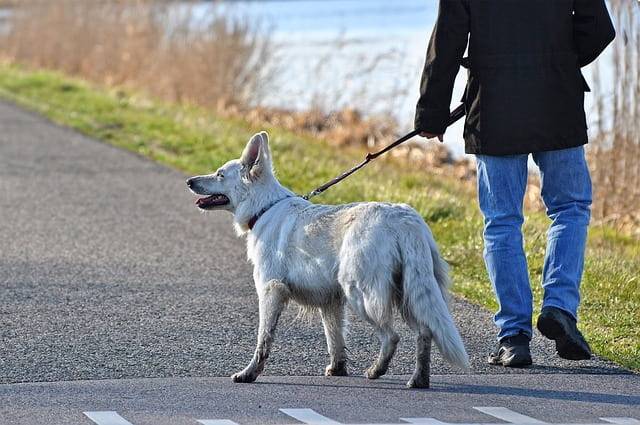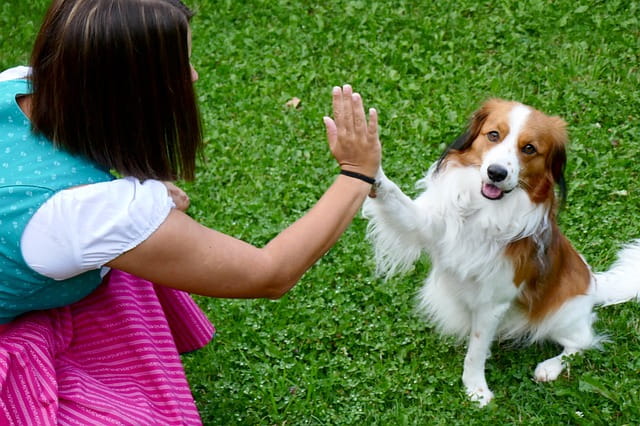Have you ever heard about long leash dog training?
If not, then this is for you, A full-fledged description of long leash dog training.
Dog training is a multifaceted journey where finding the right approach can make all the difference.
Long-leash dog training stands out as a method that provides control and even freedom, allowing dogs to explore their surroundings while still following commands.
In this guide, we’ll explore the ins and outs of long-leash dog training, covering everything from its benefits and techniques to practical tips for success. So, let’s dive in…
Understanding Long-Leash Dog Training
Long-leash dog training involves using an extended leash, typically 20 to 50 feet, to teach and reinforce obedience commands while giving dogs more freedom to roam within boundaries.
Unlike traditional leash training, where the leash is kept short and close to the handler, long leash training enables dogs to explore their surroundings within specified boundaries while still under supervision.
This method particularly benefits dogs that thrive on physical activity and mental stimulation, providing opportunities for exercise, exploration, and socialization in various environments.
Principles of Long-Leash Dog Training
-
Gradual Introduction:
Begin by familiarising your dog with the long leash in a controlled environment like your backyard or a quiet park. And then allow them to drag the leash while supervised, gradually increasing their comfort level with the extended range.
-
Positive Reinforcement:
Secondly, rewards such as treats, praise, and toys should reinforce desired behaviors. Positive reinforcement encourages dogs to associate obedience with pleasurable outcomes and strengthens their motivation to comply with commands.
-
Clear Communication:
Clear Communication
Maintain clear and consistent communication with your dog through verbal cues, hand signals, and body language. Establishing a common language facilitates understanding and facilitates effective training sessions.
-
Patience and Persistence:
Rome was not built a day ago, nor is a well-trained dog. Be patient with your pet and persistently reinforce desired behaviors, understanding that learning takes time and repetition.
-
Safety First:
First, prioritize safety by choosing appropriate training environments, using sturdy equipment, and monitoring your dog’s behavior closely to prevent accidents or injuries.
-
Keep Training Sessions Short and Engaging:
Lastly, Dogs have short attention spans, so keep training sessions brief (10-15 minutes) and focus on one or two commands at a time. Keep the sessions fun and engaging to maintain your dog’s interest and motivation.
Techniques for Long-Leash Dog Training
-
Recall Long Leash Dog Training:
The first one is recall training. Teach your dog to come when called by using the long leash to increase the distance between you and your pet gradually. Start with short distances and gradually extend the range as your dog responds to the recall command.
-
Boundary Long Leash Dog Training:
The second one is boundary training. Establish boundaries for your dog’s movement using the long leash, such as marking the perimeter of a designated area with flags or visual markers. Encourage your dog to stay within the boundaries through positive reinforcement and gentle redirection.
-
Distraction Long Leash Dog Training:
The third one is distraction Training. Introduce distractions gradually during training sessions to simulate real-world environments and teach your dog to focus on commands despite distractions. Start with mild distractions and progressively increase the difficulty level as your dog becomes more focused.
-
Socialisation Exercises:
Use the long leash to facilitate controlled socialization experiences with other dogs, people, and environments. Furthermore, supervise interactions closely and intervene if necessary to ensure positive and safe experiences for your dog.
-
Advanced Commands:
Once your dog has mastered basic obedience commands on the long leash, you can now progress to more advanced commands and activities, such as off-leash hiking, agility training, or scent work.
Benefits of Long-Leash Dog Training
-
Enhanced Safety:
By providing dogs with the freedom to explore within boundaries, long-leash training reduces the risk of leash-related accidents and allows for safer outdoor adventures.
-
Stronger Bond:
Training sessions with patience, consistency, and positive reinforcement strengthen the bond between dogs and their owners, fostering trust, mutual respect, and understanding.
-
Increased Confidence:
Increased Confidence Long leash training empowers dogs to make choices within boundaries. Moreover, it promotes confidence, independence, and problem-solving skills.
-
Versatility:
Long-leash training adapts to various training goals, environments, and even more dog breeds. These features make it a versatile and practical approach to obedience training.
-
Enhanced Freedom:
Long leash training allows dogs to explore. Their environment is more free while still under supervision. It is particularly beneficial for high-energy breeds that require ample exercise and stimulation.
-
Improved Recall:
By practising recall commands on a long leash, dogs learn to come when called, even at a distance. Moreover, this training is especially useful for off-leash activities such as hiking or visits to the dog park, where reliable recall is essential for safety.
-
Better Socialization:
Long leash training allows dogs to interact with other dogs and even with people in a controlled manner, helping them develop good social skills and manners. It also provides opportunities for exposure to various environments and stimuli, which can reduce the likelihood of fear or anxiety in new situations.
-
Building Trust:
In addition to other benefits, long-leash training builds trust and partnership between the dog and the handler. By giving the dog more freedom within boundaries and rewarding desired behaviors, the handler reinforces their bond and establishes themselves as a reliable leader.
Practical Tips for Long-Leash Dog Training Success
-
Start Early:
Firstly, begin long leash training as early as possible to instil good habits and behaviors in your dog from a young age.
-
Be Consistent:
Consistency is key to successful long-leash training. It’s equally important as any other factor in training. Stick to a regular training schedule and then reinforce commands consistently to achieve desired results.
-
Stay Positive:
Maintain a positive and encouraging attitude during training sessions, celebrate your dog’s successes, and remain patient during setbacks.
-
Seek Professional Guidance:
Consider enlisting the help of a professional dog trainer, especially if you encounter challenges or behavioral issues that require expert intervention.
-
Practice Patience:
Remember that every dog learns at their own pace, and progress may vary depending on age, breed, and temperament. Practice patience and persistence, and celebrate the small victories along the way.
Testimonials: Long-Leash Dog Training
Long-leash dog training has transformed the lives of countless dog owners and their furry companions, too. Here are some testimonials from individuals who have experienced this training method firsthand and further recommend the benefits of long-leash training.
Sarah W. – Colorado, USA:
“Long leash training has been a game-changer for my energetic Labrador, Max. Before we started long leash training, I struggled to control him on walks, especially when he spotted a squirrel or another dog. With the guidance of our trainer, we implemented long leash techniques, and the results were incredible. Max now responds reliably to recall commands, even at a distance, and I feel more confident letting him explore off-leash in safe environments.”
David R. – Ontario, Canada:
As a first-time dog owner, I was overwhelmed by the challenge of training my energetic Australian Shepherd, Luna. Traditional leash training methods didn’t work for us, as Luna would often pull and lunge at distractions. That’s when I discovered long-leash training. Working with a professional trainer, we gradually introduced Luna to the long leash and practised recall commands in various environments. The transformation has been remarkable. Luna now walks calmly by my side and responds promptly to recall. Long leash training has improved Luna’s behavior and given me the confidence to enjoy our adventures together.
Long-leash dog training offers a balanced approach to obedience training, allowing dogs to enjoy greater freedom while still learning to follow commands and respect boundaries.
Dog owners can build trust, communication, and mutual respect with their canine companions by understanding the principles, techniques, and benefits of long-leash training and applying practical tips for success.
So, grab your long leash and embark on this rewarding journey of training and bonding with your beloved four-legged friend. You’ll be amazed at what you and your dog can achieve together.




Thank you for your sharing. I am worried that I lack creative ideas. It is your article that makes me full of hope. Thank you. But, I have a question, can you help me?